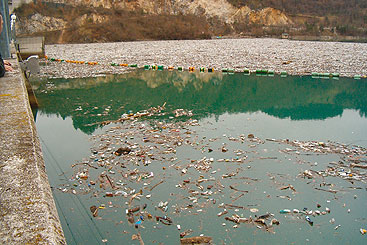The Drina River’s floating problem
ICPDR Danube Watch: Ecotourism boost in Danube-Drava National Park

The Drina River’s floating problem
Cigarette butts, old tyres, plastic bottles, fast food containers, raw sewage and vast amounts of waste from communities, livestock, hospitals and industry, threaten to spoil the ecological health of a unique natural resource.

Flooding waste backs up behind the dam of the Višegrad power plant on the Drina River.
The Drina River is the biggest tributary of the Sava River, and the last tributary before the Sava meets the Danube in Belgrade. The Drina River Basin covers 80 km² in Bosnia and Herzegovina, Montenegro and Serbia – an area home to 650,000 people.
The area is a unique natural resource. The Drina crosses three national parks: the Durmitor National Park in Montenegro, Sutjeska National Park in Bosnia and the Tara National Park in Serbia. The Drina River Basin is home to the second deepest canyon in the world, the Tara River Canyon. At nearly 100 km long and about 1800 km deep, the canyon is protected as a UNESCO World Heritage site and is a popular river rafting route.
THE DRINA RIVER
Length: 346 km
Size of basin: 80 km²
Countries in the sub-basin:
Bosnia and Herzegovina, Montenegro and Serbia
Inhabitants: about 650,000
Major tributaries: the Sutjeska,
Cehotina, Lim and Rzav rivers
The Drina in jeopardy. Unfortunately, this important area has come under threat of many unregulated dumps of untreated or inadequately treated waste, and wastewaters are discharged into the river and its tributaries. Towns downstream do not have regulated dumping sites and approximately 30% of all flooding waste ends up in the riverbed.
According to a study of the Lim River, every year more than 100,000 m3 of organic and PVC waste ends up in the river without any treatment. The disposal of waste from communities, livestock, hospitals and industry – as well as hazardous waste from town dumps – presents everyday risks for all of the river’s ecosystems.
More than an aesthetic problem. In addition, floating debris disrupts the work of motors and machines in the river causing significant costs for repairs and cleaning. Accumulation of debris blocks hydropower dams reducing energy production. The influence of discharged waste is significant when looking at the total pollution of the Drina River, and this problem must be solved urgently taking the economic, social and cultural situations into consideration.
To solve the Drina’s waste problem sustainably, it is necessary to synchronise efforts at national and international level because transboundary water resources and their preservation, protection and sustainable uses are of great importance for all countries.
THE ANNUAL PRODUCTION OF MUNICIPAL WASTE INTO
THE DRINA RIVER BASIN
| Bosnia and Herzegovina | Montenegro | Serbia | |
| Number of
towns in basin |
10 | 7 | 8 |
| Inhabitants | 310,000 | 146,000 | 210,000 |
| Produced waste* | 90,000 | 35,000 | 60,000 |
| Treated waste* | 0 | 0 | 0 |
| Released into the river * |
20,000 | 12,000 | 23,000 |
* in tonnes per year





